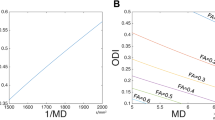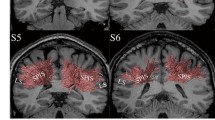Abstract
Mammalian cerebral cortices are characterized by elaborate convolutions. Radial convolutions exhibit homology across primate species and generally are easily identified in individuals of the same species. In contrast, circumferential convolutions vary across species as well as individuals of the same species. However, systematic study of circumferential convolution patterns is lacking. To address this issue, we utilized structural MRI (sMRI) and diffusion MRI (dMRI) data from primate brains. We quantified cortical thickness and circumferential convolutions on gyral banks in relation to axonal pathways and density along the gray matter/white matter boundaries. Based on these observations, we performed a series of computational simulations. Results demonstrated that the interplay of heterogeneous cortex growth and mechanical forces along axons plays a vital role in the regulation of circumferential convolutions. In contrast, gyral geometry controls the complexity of circumferential convolutions. These findings offer insight into the mystery of circumferential convolutions in primate brains.







Similar content being viewed by others
References
Bayly, P. V., Okamoto, R. J., Xu, G., Shi, Y., & Taber, L. A. (2013). A cortical folding model incorporating stress-dependent growth explains gyral wavelengths and stress patterns in the developing brain. Physical Biology, 10(1), 016005.
Bayly, P. V., Taber, L. A., & Kroenke, C. D. (2014). Mechanical forces in cerebral cortical folding: A review of measurements and models. Journal of the Mechanical Behavior of Biomedical Materials, 29, 568–581.
Beck, K. D., Powell-Braxton, L., Widmer, H. R., Valverde, J., & Hefti, F. (1995). Igf1 gene disruption results in reduced brain size, CNS hypomyelination, and loss of hippocampal granule and striatal parvalbumin-containing neurons. Neuron, 14(4), 717–730.
Behrens, T. E., Berg, H. J., Jbabdi, S., Rushworth, M. F., & Woolrich, M. W. (2007). Probabilistic diffusion tractography with multiple fibre orientations: What can we gain? NeuroImage, 34(1), 144–155.
Borrell, V., & Götz, M. (2014). Role of radial glial cells in cerebral cortex folding. Current Opinion in Neurobiology, 27C, 39–46.
Brown, M., Keynes, R., & Lumsden, A. (2002). The developing brain. Oxford: Oxford University Press.
Budday, S., Steinmann, P., & Kuhl, E. (2014). The role of mechanics during brain development. Journal of the Mechanics and Physics of Solids., 72, 75–92.
Budde, M. D., & Annese, J. (2013). Quantification of anisotropy and fiber orientation in human brain histological sections. Frontiers in Integrative Neuroscience, 7, 3.
Cao, Y., Jiang, Y., Li, B., & Feng, X. (2012). Biomechanical modeling of surface wrinkling of soft tissues with growth-dependent mechanical properties. Acta Mechanica Solida Sinica, 25, 483–492.
Cartwright, J. H. (2002). Labyrinthine turing pattern formation in the cerebral cortex. Journal of Theoretical Biology, 217(1), 97–103.
Caviness Jr., V. S. (1975). Mechanical model of brain convolutional development. Science, 189(4196), 18–21.
Chen, H., Guo, L., Nie, J., Zhang, T., Hu, X., & Liu, T. (2010). A dynamic skull model for simulation of cerebral cortex folding. Med Image Comput Comput Assist Interv., 13(2), 412–419.
Chen, H., Zhang, T., Guo, L., Li, K., Yu, X., Li, L., Hu, X., Han, J., Hu, X., & Liu, T. (2013). Coevolution of gyral folding and structural connection patterns in primate brains. Cerebral Cortex, 23(5), 1208–1217.
Cunningham, D. J., & Horsley, V. (1892). Contribution to the surface anatomy of the cerebral hemispheres. Dublin: Royal Irish Academy.
Dale, A. M., Fischl, B., & Sereno, M. I. (1999). Cortical surface-based analysis: I. Segmentation and surface reconstruction. NeuroImage, 9, 179–194.
Destrieux, C., Fischl, B., Dale, A., & Halgren, E. (2010). Automatic parcellation of human cortical gyri and sulci using standard anatomical nomenclature. NeuroImage, 53(1), 1–15.
Encha-Razavi, F., & Sonigo, P. (2003). Features of the developing brain. Child's Nervous System, 19, 426–428.
Fischl, B., & Dale, A. M. (2000). Measuring the thickness of the human cerebral cortex from magnetic resonance images. Proceedings of the National Academy of Sciences of the United States of America, 97(20), 11050–11055.
Fischl, B., Sereno, M., & Dale, A. (1999a). Cortical surface-based analysis-II: Inflation, flattening, and a surface-based coordinate system. NeuroImage, 9, 195–207.
Fischl, B., Sereno, M. I., Tootell, R. B. H., & Dale, A. M. (1999b). High-resolution intersubject averaging and a coordinate system for the cortical surface. Human brain mapping., 8, 272–284.
Fischl, B., Liu, A., & Dale, A. M. (2001). Automated manifold surgery: Constructing geometrically accurate and topologically correct models of the human cerebral cortex. Medical Imaging, IEEE Transactions on, 20, 70–80.
Fischl, B., Salat, D. H., Busa, E., Albert, M., Dieterich, M., Haselgrove, C., van der Kouwe, A., Killiany, R., Kennedy, D., & Klaveness, S. (2002). Whole brain segmentation: Automated labeling of neuroanatomical structures in the human brain. Neuron, 33, 341–355.
Fischl, B., Rajendran, N., Busa, E., Augustinack, J., Hinds, O., Yeo, B. T. T., Mohlberg, H., Amunts, K., & Zilles, K. (2008). Cortical folding patterns and predicting cytoarchitecture. Cerebral Cortex., 18, 1973–1980.
Gaudillière, B., Konishi, Y., de la Iglesia, N., Gl, Y., & Bonni, A. (2004). A CaMKII-NeuroD signaling pathway specifies dendritic morphogenesis. Neuron, 41(2), 229–241.
Geng, G., Johnston, L. A., Yan, E., Britto, J. M., Smith, D. W., Walker, D. W., & Egan, G. F. (2009). Biomechanisms for modelling cerebral cortical folding. Medical Image Analysis, 13(6), 920–930.
Glasser, M. F., Sotiropoulos, S. N., Wilson, J. A., Coalson, T. S., Fischl, B., Andersson, J. L., Xu, J., Jbabdi, S., Webster, M., Polimeni, J. R., Van Essen, D. C., Jenkinson, M., & Consortium, W. U.-M. H. C. P. (2013). The minimal preprocessing pipelines for the human connectome project. NeuroImage, 80, 105–124.
Götz, M., & Huttner, W. B. (2005). The cell biology of neurogenesis. Nature Reviews. Molecular Cell Biology, 6, 777–788.
Gratiolet, L. P. (1854). On the folding of cortical folding of the human and primates brain. Paris: Bertrand (Fre).
Hilgetag, C. C., & Barbas, H. (2005). Developmental mechanics of the primate cerebral cortex. Anatomy and Embryology, 210(5–6), 411–417.
Holland, M. A., Miller, K. E., & Kuhl, E. (2015). Emerging brain morphologies from axonal elongation. Annals of Biomedical Engineering, 43(7), 1640–1653.
Jenkinson, M., Beckmann, C. F., Behrens, T. E., Woolrich, M. W., & Smith, S. M. (2012). FSL. Neuro Image, 62, 782–790.
Jin, L., Cai, S., & Suo, Z. (2011). Creases in soft tissues generatsed by growth. EPL, 95, 64002.
Konishi, Y., Stegmüller, J., Matsuda, T., Bonni, S., & Bonni, A. (2004). Cdh1-APC controls axonal growth and patterning in the mammalian brain. Science, 303(5660), 1026–1030.
Le Gros Clark, W. (1945). Deformation patterns on the cerebral cortex. In Essays on growth and form (pp. 1–23). Oxford: Oxford University Press.
Leighton PA, Mitchell KJ, Goodrich LV, Lu X, Pinson K, Scherz P, Skarnes WC, Tessier-Lavigne M. (2001). Defining brain wiring patterns and mechanisms through gene trapping in mice. 410(6825):174–9.
Li, G., Guo, L., Nie, J., & Liu, T. (2010). An automated pipeline for cortical sulcal fundi extraction. Medical Image Analysis, 14(3), 343–359.
Li, G., Liu, T., Ni, D., Lin, W., Gilmore, J. H., & Shen, D. (2015). Spatiotemporal patterns of cortical fiber density in developing infants, and their relationship with cortical thickness. Human Brain Mapping., 36, 5183.
Liu T., Li H., Wong K., Tarokh A., Guo L., Wong S.T. (2007). Brain tissue segmentation based on DTI data. Neuroimage. 38(1),114–23.
Liu T., Nie J., Tarokh A., Guo L., Wong S.T. (2008). Reconstruction of central cortical surface from brain MRI images: Method and application. Neuroimage. 40(3):991-1002.
Nie, J., Guo, L., Li, K., Wang, Y., Chen, G., Li, L., Chen, H., Deng, F., Jiang, X., Zhang, T., Huang, L., Faraco, C., Zhang, D., Guo, C., Yap, P. T., Hu, X., Li, G., Lv, J., Yuan, Y., Zhu, D., Han, J., Sabatinelli, D., Zhao, Q., Miller, L. S., Xu, B., Shen, P., Platt, S., Shen, D., Hu, X., & Liu, T. (2012). Axonal fiber terminations concentrate on gyri. Cerebral Cortex, 22(12), 2831–2839.
Raghavan, R., Lawton, W., Ranjan, S. R., & Viswanathan, R. R. (1997). A continuum mechanics-based model for cortical growth. Journal of Theoretical Biology., 187(2), 285–296.
Razavi, M. J., & Wang, X. (2015c). Morphological patterns of a growing biological tube in a confined environment with contacting boundary. RSC Advances, 5, 7440–7449.
Razavi, M. J., Zhang, T., Liu, T., & Wang, X. (2015a). Cortical folding pattern and its consistency induced by biological growth. Scientific Reports., 5, 14477.
Razavi, M. J., Zhang, T., Li, X., Liu, T., & Wang, X. (2015b). Role of mechanical factors in cortical folding development. Physical Review E, 92, 032701.
Régis, J., Mangin, J. F., Ochiai, T., Frouin, V., Riviére, D., Cachia, A., Tamura, M., & Samson, Y. (2005). "sulcal root" generic model: A hypothesis to overcome the variability of the human cortex folding patterns. Neurologia Medico-Chirurgica (Tokyo), 45(1), 1–17.
Richman, D. P., Stewart, R. M., Hutchinson, J. W., & Caviness, V. S. (1975). Mechanical model of brain convolutional development. Science, 189(4196), 18–21.
Ronan, L., Voets, N., Rua, C., Alexander-Bloch, A., Hough, M., Mackay, C., Crow, T. J., James, A., Giedd, J. N., & Fletcher, P. C. (2014). Differential tangential expansion as a mechanism for cortical gyrification. Cerebral Cortex, 24(8), 2219–2228.
Ségonne, F., Grimson, E., Fischl, B. (2005). Information Processing in Medical Imaging. In A genetic algorithm for the topology correction of cortical surfaces (pp. 213–259). Springer.
Sidman, R. L., & Rakic, P. (1973). Neuronal migration, with special reference to developing human brain: A review. Brain Research, 62, 1–35.
Stahl, R., Walcher, T., De Juan, R. C., Pilz, G. A., Cappello, S., Irmler, M., Sanz-Aquela, J. M., Beckers, J., Blum, R., Borrell, V., & Götz, M. (2013). Trnp1 regulates expansion and folding of the mammalian cerebral cortex by control of radial glial fate. Cell, 153(3), 535–549.
Sun, T., & Hevner, R. F. (2014). Growth and folding of the mammalian cerebral cortex: From molecules to malformations. Nature Reviews. Neuroscience, 15(4), 217–232.
Sur, M., & Rubenstein, J. L. R. (2005). Patterning and plasticity of the cerebral cortex. Science, 310, 805–810.
Tallinen, T., Chung, J. Y., Biggins, J. S., & Mahadevan, L. (2014). Gyrification from constrained cortical expansion. Proceedings of the National Academy of Sciences of the United States of America, 111(35), 12667–12672.
Toro, R., & Burnod, Y. (2005). A morphogenetic model for the development of cortical convolutions. Cerebral Cortex., 15(12), 1900–1913.
Van Essen, D. C. (1997). A tension-based theory of morphogenesis and compact wiring in the central nervous system. Nature, 385, 313–318.
White, T., Andreasen, N., & Nopoulos, P. (2002). Brain volumes and surface morphology in monozygotic twins. Cerebral Cortex, 12, 486–493.
Xu, G., Bayly, P. V., & Taber, L. A. (2009). Residual stress in the adult mouse brain. Biomechanics and Modeling in Mechanobiology, 8(4), 253–262.
Xu, G., Knutsen, A. K., Dikranian, K., Kroenke, C. D., Bayly, P. V., & Taber, L. A. (2010). Axons pull on the brain, but tension does not drive cortical folding. Journal of Biomechanical Engineering, 132(7), 071013.
Acknowledgements
T Zhang was supported by NSFC 31500798, NSFC 31671005. T Liu was supported by NSF CAREER Award (IIS-1149260), NIH R01 DA-033393, NIH R01 AG-042599, NSF CBET-1302089, NSF BCS-143905 and NSF DBI-1564736. X Wang and M Razavi were supported by the University of Georgia Start-up research funding.
Author information
Authors and Affiliations
Corresponding authors
Ethics declarations
Conflict of interest
The authors declare that they have no conflict of interest
Additional information
Action Editor: Abraham Zvi Snyder
Tuo Zhang and Mir Jalil Razavi contributed equally to this work.
Electronic supplementary material
ESM 1
(DOCX 4264 kb)
Rights and permissions
About this article
Cite this article
Zhang, T., Razavi, M.J., Chen, H. et al. Mechanisms of circumferential gyral convolution in primate brains. J Comput Neurosci 42, 217–229 (2017). https://doi.org/10.1007/s10827-017-0637-9
Received:
Revised:
Accepted:
Published:
Issue Date:
DOI: https://doi.org/10.1007/s10827-017-0637-9




